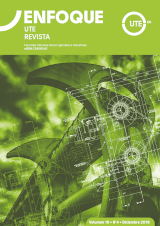Effect of the filling percentage on tensile strength in 3D desktop printing for different printing patterns, using a randomized design of experiments
DOI:
https://doi.org/10.29019/enfoque.v10n4.503Keywords:
3D printing; Filling percentage; Filling pattern; PLA; Stress.Abstract
The evaluation of the tensile strength of printed parts by means of fused deposition modeling (FDM) or fused filament fabrication (FFF) is essential, since parts whose resistance does not differ significantly depending on the percentage of filling used can be obtained, optimizing the use of the material. The present work details the analysis of polylactic acid (PLA) specimens manufactured according to ASTM D 638 with different percentages for the most commonly used filling patterns (Honeycomb, Octagram, Stars, Archimedean, Hilbert and Triangles). With the help of an analysis of variance and a design of experiments with a single factor, the appropriate percentages for printing parts according to the desired filling pattern are obtained.
Downloads
References
ASTM D3039. (2008). Standard test method for tensile properties of polymer matrix composite materials. ASTM International, West Conshohocken, PA. doi: 10.1520/D3039_D3039M-17
ASTM D638-14. (2014). Standard test method for tensile properties of plastics. ASTM International, West Conshohocken, PA. doi: 10.1520/D0638-14
ALLEVI. (2014). Infill Options on Slic3r. Recuperado de https://allevi3d.com/build-with-life/infill-slic3r (accedido el 09/07/2019).
Castillo, E., Loor, O., Muñoz, C., Naranjo, C., Padrón, D., y Peralta, D. (2016). Diseño y construcción de una máquina para ensayos de tracción. p.6. Quito, Ecuador: Universidad Internacional del Ecuador
Cazañas, A., De San Miguel, A. y Parra, E. (2017). Estimación del tamaño de la muestra para pruebas de usabilidad. Quito, Ecuador. Enfoque UTE, 7(1), 172-185.
Díaz Abad, J. (2016). Bioprinting: el mundo del 3D en la medicina. (Documento electrónico). Elsevier. Recuperado de https://www.elsevier.com/es-es/connect/ciencia/bioprinting-el-mundo-del-3d-en-la-medicina (accedido el 08/07/2019).
Escobar, J., y Escobar, R. (2018). Determinación de la velocidad óptima para la soldadura MIG de la aleación 5086-H116, mediante ensayo de dureza, prueba de tracción y examen metalográfico para la fabricación de tanqueros de aluminio. Enfoque UTE, 9(3), 42-49.
ESUN. (2007). Product and Services. (Documento electrónico). Recuperado de http://www.esun3d.net/Products/PLA (accedido el 09/07/2019).
Fernandez, M., Calle, W., Ferrandiz, S. y Conejero, A. (2016). Effect of Infill Parameters on Tensile Mechanical Behavior in Desktop 3D Printing. 3D Printing and Additive Manufacturing, 3(3). doi: 10.1089/3dp.2015.0036
González, J. (2009) Manual Básico SPSS. Talca, Chile: Centro de Inserción Laboral Programa Jóvenes Profesionales.
Haid C. (2014). Characterizing Tensile Loading Responses of 3D Printed Samples. Massachusetts , EE.UU.: Massachusetts Institute of Technology, 38-40.
Juiña, L., Cabrera, V., y Reina, S. (2017). Aplicación de la teoría de restricciones en la implementación de un Sistema de Manufactura CAD-CAM en la industria Metalmecánica-Plástica, Caso de estudio Quito, Ecuador. Enfoque UTE, 8(3), 56-71.
Pérez, M (2014). Diseño de experimentos. Aplicaciones con IBM SPSS. Createspace Independent Publishing Platform.
Pulido, H. G., De la Vara Salazar, R., González, P. G., Martínez, C. T., & Pérez, M. D. C. T. (2012). Análisis y diseño de experimentos. New York, EE.UU.: McGraw-Hill.
Molina, R., Pender, G., Moro, L., y Piovan, M. (2018). Comportamiento al creep de un polímero utilizado para impresión 3D. Revista Materia, 23(2).
Montgomery D.C. (2004). Diseño y Análisis de Experimentos. 2da edición. Arizona, EE.UU.: Universidad Estatal de Arizona.
Navas, A., Reyes, R. y Galván, L. (2015). Impactos ambientales asociados con el proceso de producción del concreto. Enfoque UTE, 6(4), 67-80.
Ordoñez-Alemán, G. (2017). La contribución al emprendimiento ecuatoriano de una empresa de tecnología 3D. Revista de Negocios y PYMES 2017. 3-7:35-46.
Tamayo, I., Pazmiño, L., Galván, M. y Batista, M. (2015). Implementación de prácticas de laboratorio con costo mínimo. Quito, Ecuador. Enfoque UTE, 6(2), 44-58.
Wittbrodt B. y Pearce J.M., (2015) The Effects of PLA Color on Material Properties of 3-D Printed Components. Additive Manufacturing, 8(1), 110-116
Published
How to Cite
Issue
Section
License
Copyright (c) 2019 Enfoque UTE

This work is licensed under a Creative Commons Attribution 3.0 Unported License.
The articles and research published by the UTE University are carried out under the Open Access regime in electronic format. This means that all content is freely available without charge to the user or his/her institution. Users are allowed to read, download, copy, distribute, print, search, or link to the full texts of the articles, or use them for any other lawful purpose, without asking prior permission from the publisher or the author. This is in accordance with the BOAI definition of open access. By submitting an article to any of the scientific journals of the UTE University, the author or authors accept these conditions.
The UTE applies the Creative Commons Attribution (CC-BY) license to articles in its scientific journals. Under this open access license, as an author you agree that anyone may reuse your article in whole or in part for any purpose, free of charge, including commercial purposes. Anyone can copy, distribute or reuse the content as long as the author and original source are correctly cited. This facilitates freedom of reuse and also ensures that content can be extracted without barriers for research needs.
This work is licensed under a Creative Commons Attribution 3.0 International (CC BY 3.0).
The Enfoque UTE journal guarantees and declares that authors always retain all copyrights and full publishing rights without restrictions [© The Author(s)]. Acknowledgment (BY): Any exploitation of the work is allowed, including a commercial purpose, as well as the creation of derivative works, the distribution of which is also allowed without any restriction.























 Enfoque UTE - Facultad de Ciencias de la Ingeniería e Industrias - Universidad UTE
Enfoque UTE - Facultad de Ciencias de la Ingeniería e Industrias - Universidad UTE